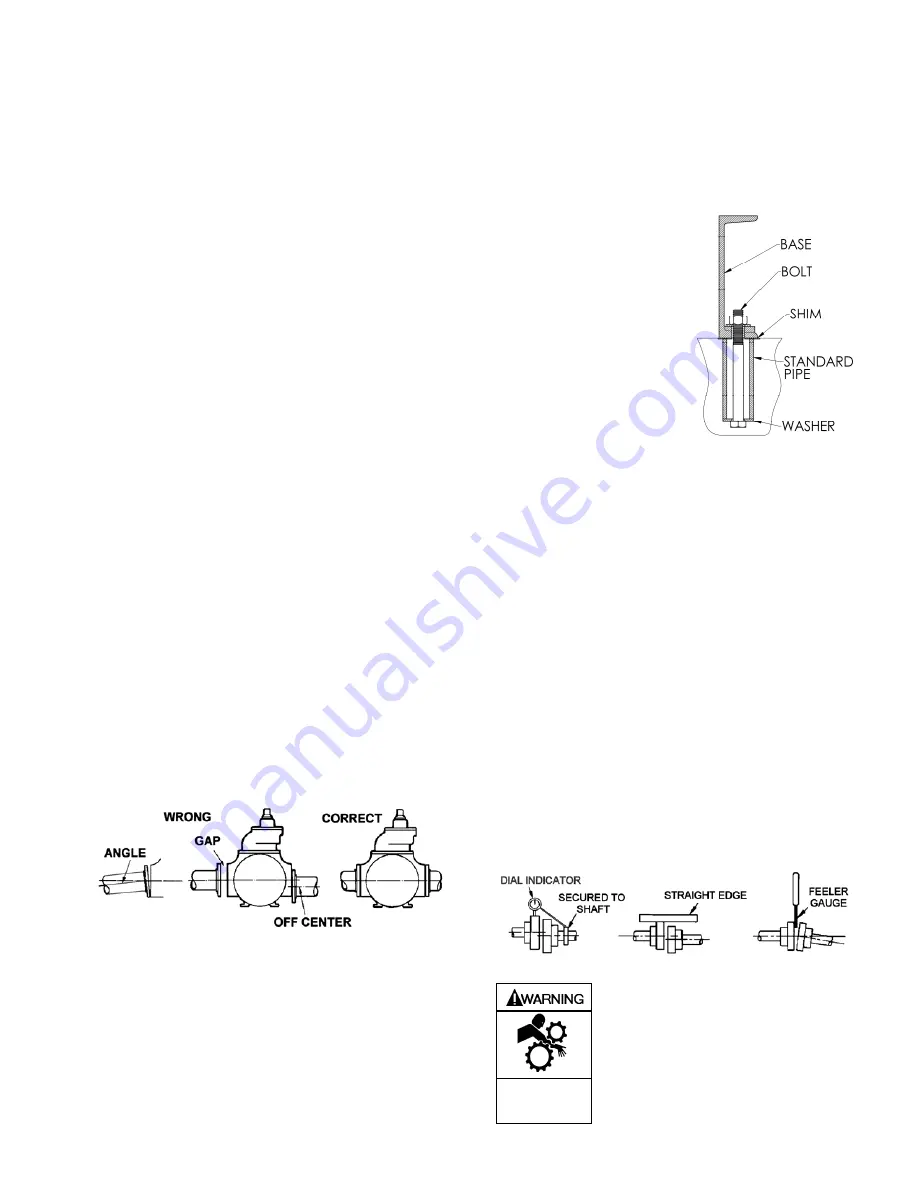
107-B00 Page 3/16
INSTALLATION
PRE-INSTALLATION CLEANING
NOTICE:
New pumps contain residual test fluid and rust inhibitor.
If necessary, flush pump prior to use.
Foreign matter entering the pump WILL cause extensive
damage. The supply tank and intake piping MUST be
cleaned and flushed prior to pump installation and operation.
LOCATION AND PIPING
Pump life and performance can be significantly reduced when
installed in an improperly designed system. Before starting
the layout and installation of the piping system, review the
following:
1. Locate the pump as near as possible to the source of
supply to avoid excessive inlet pipe friction.
2. The inlet line MUST be at least as large as the intake
port on the pump. It should slope downward to the pump,
and should not contain any upward loops. Eliminate
restrictions such as sharp bends; globe valves,
unnecessary elbows, and undersized strainers.
3. It is recommended a strainer be installed in the inlet line
to protect the pump from foreign matter. The strainer
should be located at least 24" (0.6m) from the pump, and
have a net open area of at least four times the area of
the intake piping. Strainers must be cleaned regularly to
avoid pump starvation.
4. The intake system must be free of air leaks.
5. Expansion joints, placed at least 36" (0.9m) from the
pump, will compensate for expansion and contraction of
the pipes. Contact the flexible connector/hose
manufacturer for required maintenance/care and design
assistance in their use.
6.
Install pressure gauges in the NPT ports provided in the
pump casing to check pump at start up.
7. ALL piping and fittings MUST be properly supported to
prevent any piping loads from being placed on the pump.
8. Check alignment of pipes to pump to avoid strains which
might later cause misalignment. See Figure 1. Unbolt
flanges or break union joints. Pipes should not spring
away or drop down. After pump has been in operation
for a week or two, completely recheck alignment.
Figure 1
9. When pumping liquids at elevated temperature,
provisions should be made to compensate for expansion
and contraction of the pipes, especially when long pipe
lines are necessary. Steel pipe expands approximately
3/4” (1.9 cm) per 100 feet (30.49 m) per 100°F (37.8°C)
rise in temperature.
PUMP MOUNTING
A solid foundation reduces noise and vibration, and will
improve pump performance. On permanent installations it is
recommended the pumping unit be secured by anchor bolts
as shown in Figure 2. This arrangement allows for slight
shifting of position to accommodate alignment with the
mounting holes in the base plate.
Figure 2 - Pipe Type
Anchor Bolt Box
For new foundations, it is
suggested that the anchor
bolts be set in concrete.
When pumps are to be
located on existing concrete
floors, holes should be
drilled into the concrete to
hold the anchor bolts.
When installing units built on
channel or structural steel
type bases, use care to
avoid twisting the base out of
shape when anchor bolts are tightened. Shims should be
used under the edges of the base prior to tightening of the
anchor bolts to prevent distortion.
COUPLING ALIGNMENT
The pump must be directly coupled to a gear and/or driver
with a flexible coupling. Verify coupling alignment after
installation of new or rebuilt pumps. Both angular and
parallel coupling alignment MUST be maintained between the
pump, gear, motor, etc. in accordance with manufacturer’s
instructions. See Figure 3.
1. Parallel alignment: The use of a laser alignment tool or
dial indicator is preferred. If a laser alignment tool or dial
indicator is not available, use a straightedge. Turn both
shafts by hand, checking the reading through one
complete revolution. Maximum offset should be less
than .005" (.127 mm).
2. Angular alignment: Insert a feeler gauge between the
coupling halves. Check the spacing at 90° increments
around the coupling (four checkpoints). Maximum
variation should not exceed .005" (.127 mm). Some
laser alignment tools will check angular alignment as
well.
3. Replace the coupling guards after setting alignment.
Figure 3 – Alignment Check
Operation without guards in place can
cause serious personal injury, major
property damage, or death.
Do not operate
without guard
in place


































